#1640s Netherlands
Text

Oil Painting, 1646, Dutch.
By Gerrit Dou.
Portraying a girl in a yellow dress and blue apron and a little boy in a black plumed hat.
Royal Collection Trust.
#royal collection trust#1646#1640s#17th century#1640s Netherlands#1640s painting#netherlands#Dutch#gerrit dou
26 notes
·
View notes
Photo

tfw you try to warn the bae that some yank is coming over to cause trouble (and to jeopardise your trade monopoly)...but his govt is way too ossified and factionalised.
(so, the Tokugawa shogunate actually knew about the Perry Expedition quite far ahead, thanks to detailed reports from Dutch officials, including Dutch agents in Washington DC. despite the advance warning, they did not make sufficient political or defensive preparations—and the rest is history.)
#hetalia#nedpan#hws japan#hws netherlands#hws america#myart#(i guess he is here tho off screen lol)#alfred f jones#kiku honda#200 years instead of 250#because it was in the late 1630s-1640s that things got more isolationist
440 notes
·
View notes
Text



“Dutch King apologizes for Netherlands’ role in slavery.”
The Dutch/Netherlands abducted slaves from West Africa; hosted the Dutch West India Company; operated an extensive profitable sugar plantation industry built on slave labor; and established colonies in the greater Caribbean region including sites at Aruba, Curaçao, Sint Maarten, Bonaire, and the adjacent “Wild Coast” (land between the Orinoco and Amazon rivers, including Guyana and Suriname). Many of these places remained official colonies until between the 1950s and 1990s.
---
Scholarship on resistance to Dutch practices of slavery, colonialism, and imperialism in the Caribbean:
“Decolonization, Otherness, and the Neglect of the Dutch Caribbean in Caribbean Studies.” Margo Groenewoud. Small Axe. 2021.
“Women’s mobilizations in the Dutch Antilles (Curaçao and Aruba, 1946-1993).” Margo Groenewoud. Clio. Women, Gender, History No. 50. 2019.
“Black Power, Popular Revolt, and Decolonization in the Dutch Caribbean.” Gert Oostindie. In: Black Power in the Caribbean. Edited by Kate Quinn. 2014.
“History Brought Home: Postcolonial Migrations and the Dutch Rediscovery of Slavery.” Gert Oostindie. In: Post-Colonial Immigrants and Identity Formations in the Netherlands. Edited by Ulbe Bosma. 2012.
“Other Radicals: Anton de Kom and the Caribbean Intellectual Tradition.” Wayne Modest and Susan Legene. Small Axe. 2023.
Di ki manera? A Social History of Afro-Curaçaoans, 1863-1917. Rosemary Allen. 2007.
Creolization and Contraband: Curaçao in the Early Modern Atlantic World. Linda Rupert. 2012.
“The Empire Writes Back: David Nassy and Jewish Creole Historiography in Colonial Suriname.” Sina Rauschenbach. The Sephardic Atlantic: Colonial Histories and Postcolonial Perspectives. 2018.
“The Scholarly Atlantic: Circuits of Knowledge Between Britain, the Dutch Republic and the Americas in the Eighteenth Century.” Karel Davids. 2014. And: “Paramaribo as Dutch and Atlantic Nodal Point, 1640-1795.” Karwan Fatah-Black. 2014. And: Dutch Atlantic Connections, 1680-1800: Linking Empires, Bridging Borders. Edited by Gert Oostindie and Jessica V. Roitman. 2014.
Decolonising the Caribbean: Dutch Policies in a Comparative Perspective. Gert Oostindie and Inge Klinkers. 2003. And: “Head versus heart: The ambiguities of non-sovereignties in the Dutch Caribbean.” Wouter Veenendaal and Gert Oostindie. Regional & Federal Studies 28(4). August 2017.
Tambú: Curaçao’s African-Caribbean Ritual and the Politics of Memory. Nanette de Jong. 2012.
“More Relevant Than Ever: We Slaves of Suriname Today.” Mitchell Esajas. Small Axe. 2023.
“The Forgotten Colonies of Essequibo and Demerara, 1700-1814.” Eric Willem van der Oest. In: Riches from Atlantic Commerce: Dutch Transatlantic Trade and Shipping, 1585-1817. 2003.
“Conjuring Futures: Culture and Decolonization in the Dutch Caribbean, 1948-1975.” Chelsea Shields. Historical Reflections / Reflexions Historiques Vol. 45 No. 2. Summer 2019.
“’A Mass of Mestiezen, Castiezen, and Mulatten’: Fear, Freedom, and People of Color in the Dutch Antilles, 1750-1850.” Jessica Vance Roitman. Atlantic Studies 14, no. 3. 2017.
---
This list only covers the Caribbean.
But outside of the region, there is also the legacy of the Dutch East India Company; over 250 years of Dutch slavers and merchants in Gold Coast and wider West Africa; about 200 years of Dutch control in Bengal (the same region which would later become an engine of the British Empire’s colonial wealth extraction); over a century of Dutch control in Sri Lanka/Ceylon; Dutch operation of the so-called “Cultivation System” (”Cultuurstelsei”) in the nineteenth century; Dutch enforcement of brutal forced labor regimes at sugar plantations in Java, which relied on de facto indentured laborers who were forced to sign contracts or obligated to pay off debt and were “shipped in” from other islands and elsewhere in Southeast Asia (a system existing into the twentieth century); the “Coolie Ordinance” (”Koelieordonnanties”) laws of 1880 which allowed plantation owners to administer punishments against disobedient workers, resulting in whippings, electrocutions, and other cruel tortures (and this penal code was in effect until 1931); and colonization of Indonesian islands including Sumatra and Borneo, which remained official colonies of the Netherlands until the 1940s.
162 notes
·
View notes
Text

Balthasar van der Ast (1593/1594–1657) • Still Life with Shells • c. 1640 • Museum Boijmans Van Beuningen, Rotterdam, Netherlands
#still life#art#painting#fine art#balthasar van der ast#dutch artist#dutch golden age#17th century european art#dutch master#baroque still life#baroque art#art history#oil painting#art of the still life blog#art blogs on tumblr#art lovers on tumblr
42 notes
·
View notes
Photo
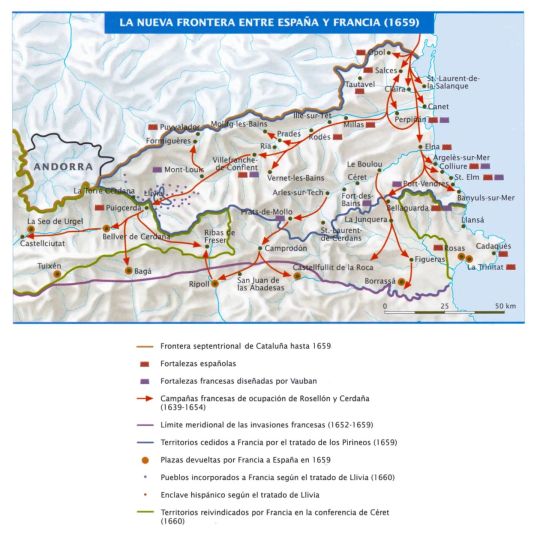
The new border between Spain and France, 1659.
via cartesdhistoire
Source: “Atlas de Historia de España”, Fdo García de Cortázar, Planeta, 2005
Within the framework of the Thirty Years' War, France declared war on Spain in May 1635. Starting in 1639, the French army invaded Roussillon, beginning with the occupation of the fortress of Salses. Richelieu fueled the revolt of the Catalans against Philip IV (started in June 1640), granting the insurgent leaders and troops the protection of French sovereignty (recognized by the insurgents in January 1641). Catalonia's return to Spanish obedience was effective only in October 1652 when Barcelona surrendered.
The fatigue produced by the French occupation, whose army was as burdensome or more burdensome than the Spanish and whose policy was more absolutist and inconsiderate than that of Olivares, alienated the population from the French, but Richelieu's move later served Louis XIV.
Indeed, the Peace of Westphalia (1648) did not put an end to the Franco-Spanish War, which ended with the defeat of Las Dunas (June 14, 1658). June 25, 1658, was the “folle journée” of neighboring Dunkirk: the city, Spanish in the morning, was taken by the French at noon and they handed it over to their ally England in the afternoon (it will be definitively French in 1662) .
The Peace of the Pyrenees (November 1659) meant the loss of Roussillon and Upper Cerdanya, with the establishment of the "dean border of Europe" between France and Spain. It also meant the definitive end of Spanish hegemony. On the other hand, one of the clauses of the treaty, which agreed to the marriage of Louis by a financially exhausted country), would later justify French interventionism in the Netherlands and, above all, would pave the way for the Spanish Crown to fall at the end of the century to the Bourbons, the current reigning dynasty in Spain.
50 notes
·
View notes
Photo
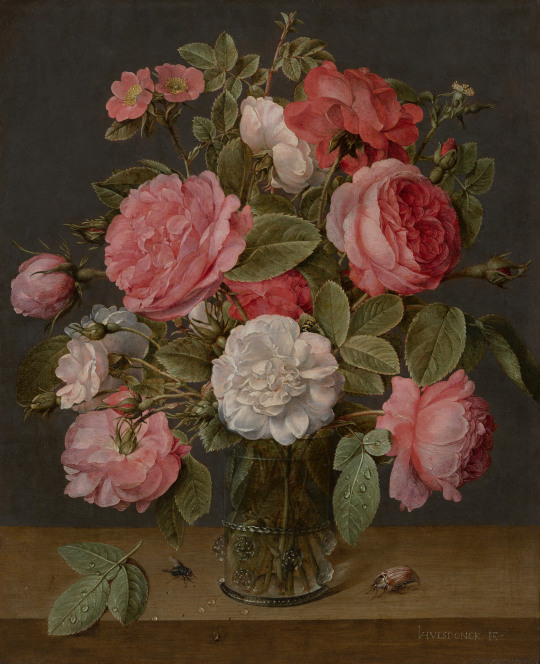
Jacob van Hulsdonck (1582-1647) - Roses in a Glass Vase, ca 1640/5
Oil on copper (35 x 28,4 cm)
Mauritshuis, The Hague (Netherlands)
229 notes
·
View notes
Text
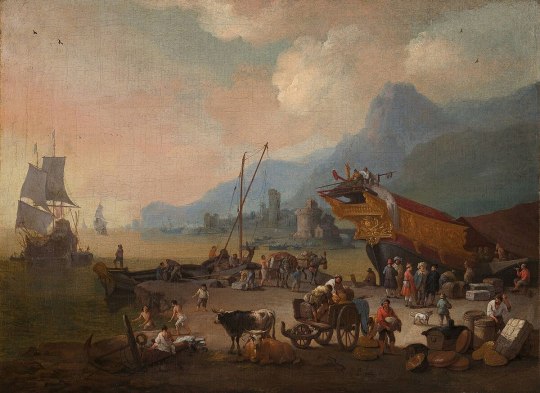
Pieter Bout - View of an Italian Harbor - 1669
oil on canvas,
Museum Boijmans Van Beuningen, Rotterdam, Netherlands
Pieter Bout (between 1640 and 1658 – between 1689 and 1719) was a Flemish painter, draughtsman and etcher. He is known mainly for his landscapes, city, coast and country views and architectural scenes painted in a style reminiscent of earlier Flemish masters such as Jan Brueghel the Elder.
33 notes
·
View notes
Photo
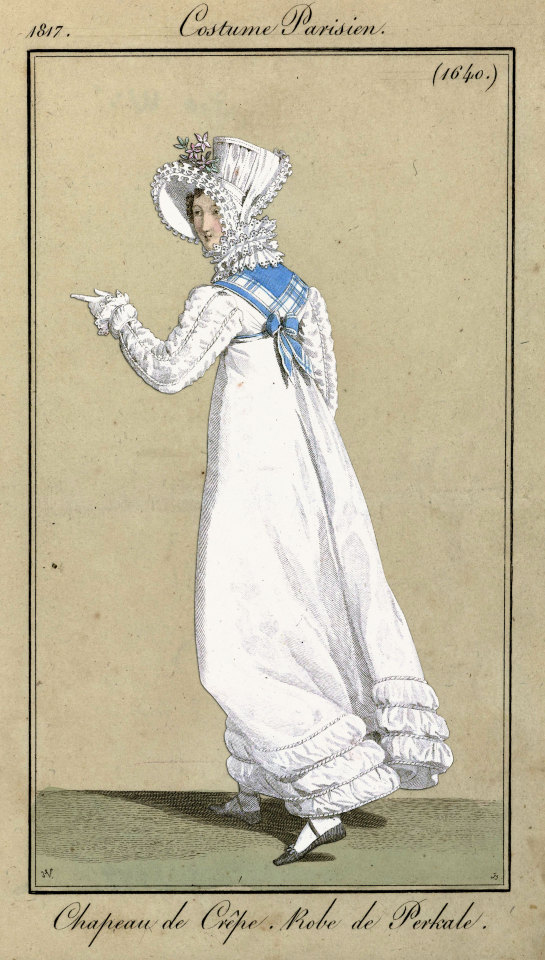
Journal des Dames et des Modes, Costume Parisien, 15 avril 1817, (1640): Chapeau de Crêpe. Robe de Perkale. Collection of the Rijksmuseum, Netherlands
Woman, seen from the back, wearing a cotton percale dress. Pleated collar, long sleeves and high waist. Crepe hat on the head. A checkered fichu around the shoulders. Belt with bow on the back. flat shoes with straps and bows. The print is part of the fashion magazine Journal des Dames et des Modes, published by Pierre de la Mésangère, Paris, 1797-1839.
#Journal des Dames et des Modes#19th century#1800s#1810s#1817#periodical#fashion#fashion plate#color#description#rijksmuseum#dress#Mésangère#fichu
46 notes
·
View notes
Text


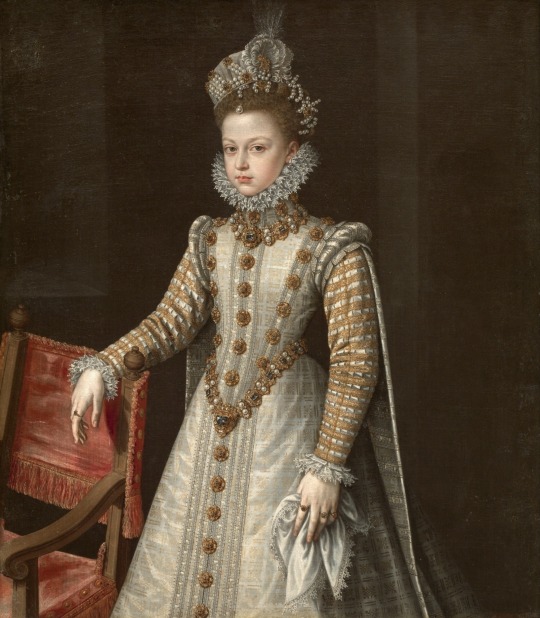

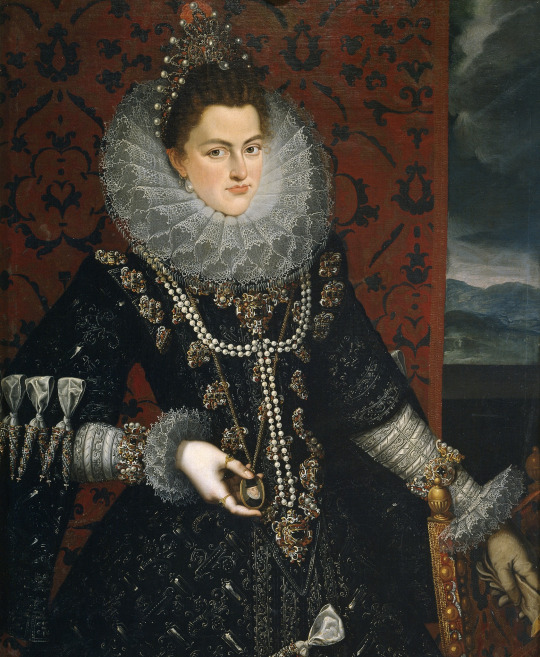

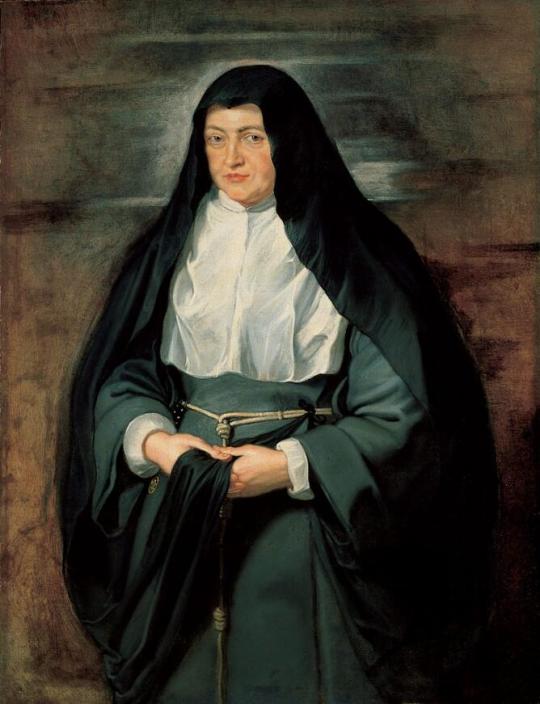

The Infanta Isabella Clara Eugenia (Spanish, 1566-1633): Sovereign of the Netherlands, Duchess of Lothier, Brabant, Limburg, Luxemburg, and Guelders, Margravine of Namur, Countess Palatine of Burgundy, Countess of Flanders, Artois and Hainaut. [source]
1. Attributed to Alonso Sánchez Coello (1531-1588) and Workshop, Isabella Clara Eugenia and Catharina, Daughters of Philip II, King of Spain, c. 1569-70, oil on canvas; The Royal Collection Trust, Green Drawing Room, Buckingham Palace.
2. Alonso Sánchez Coello (Spanish,1531-1588), The Infantas Isabel Clara Eugenia and Catalina Micaela, circa 1575, oil on canvas, Museo del Prado, Madrid.
3. Alonso Sánchez Coello (Spanish, 1531-1588), Infanta Isabella Clara Eugenia, 1577, oil on canvas, Museo del Prado, Madrid.
4. Alonso Sánchez Coello, The Infanta Isabella Clara Eugenia and Magdalena Ruiz, 1586, oil on canvas, Museo Nacional del Prado, Madrid.
5. Juan Pantoja de la Cruz (Spanish, 1553-1608), The Infanta Isabel Clara Eugenia, 1598-99, oil on canvas, Museo del Prado, Madrid.
6. Frans Pourbus the Younger (Flemish, 1569-1622), The Infanta Isabella Clara Eugenia, Archduchess of Austria, c. 1598-1600, oil on canvas.
7. Peter Paul Rubens and Workshop (Flemish, 1577-1640), Portrait of Archduchess Isabella Clara Eugenia, Spanish Regent of the Low Countries, as a Nun, 1625, oil on canvas.
8. Anthony van Dyck (Flemish, 1599-1641), The Infanta Isabella Clara Eugenia, c. 1630, oil on canvas, Walker Art Gallery.
Infanta Isabella Clara Eugenia (Spanish, Segovia, 1566 - 1633, Brussels) was the daughter of Philip II of Spain and his third wife, Elizabeth of Valois, who died after a miscarriage when the Infanta was only two. Her sister Catalina Micaela was one year younger.
She became the sovereign of the Spanish Netherlands in the Low Countries and the north of modern France with her husband, Archduke Albert VII of Austria. She was one of the most powerful women in Europe at the time. The couple had no children. She joined the Sisters of St. Clare order after her co-regent's death.
#infanta isabel clara eugenia#spanish royalty#powerful women#alonso sánchez coello#juan pantoja de la cruz#frans pourbus the younger#peter paul rubens#anthony van dyck#16th century#17th century#european history
35 notes
·
View notes
Text

LONDON.- Wellcome Collection today announced its acquisition of a 17th century portrait of businesswoman and celebrity Barbara van Beck. The painting is a rare depiction in oil paint of a woman living with a genetic condition resulting in excessive hair growth on the body.
The work has been acquired by Wellcome Collection, the free museum and library for the incurably curious. It joins five existing prints of the same woman which are held in the Collection. The painting enhances an already extensive array of portraits of individuals living with various health conditions from across centuries.
The painting, dating from the 1640s, is an authentic record of a person living with a rare congenital endocrine condition, most likely hypertrichosis, also called Ambras syndrome. It is one of the earliest depictions, along with those of the Gonzales family, of a person living with a condition in which the face and often much of the body is covered with hair. It depicts Van Beck wearing an expensive silk gown, with a low neckline emphasising her femininity whilst also being very fashionable for its time.
Barbara van Beck was born Barbara Ursler near Augsburg, Bavaria, in 1629. She married Johan Michael van Beck from the Netherlands, who became her manager and they had one child. She travelled extensively throughout Europe, including to London at least twice, once as a child and again in 1657 when writer, diarist and gentry gardener, John Evelyn (1620-1706) recorded seeing her at a show with other high-class performers. He described her hair as ‘thick and even as growes on any womans head.’ He also recounts how she was neatly dressed, ’very well shaped,’ and how she ‘played well on the Harpsichord.’ Evelyn was a good friend of Samuel Pepys, who also documented a woman in London with a similar condition some years later.
Dr Angela McShane, Research Development Manager, Wellcome Collection, said: ‘It’s difficult to imagine what it must have been like to live with a condition such as this 350 years ago, but it’s also too easy to make assumptions based on today’s social and medical norms. We know that Barbara van Beck was a successful public figure, renowned internationally, and that she turned this condition to her advantage. There’s so much more to understand about this work, and by making it available to a wider audience we hope not just to further our understanding of the very different social and medical context of this period, but also to challenge ourselves to think about life, health and our place in the world.’
Courtesy Alain Truong
63 notes
·
View notes
Text
Portuguese Restoration War (1640-1668)
England’s hair tumbled around his face, framing sharp cheeks, as he slowly bent his knee, head bowed; Hands reaching out to gently take Portugal’s hand and lips gently kissing each ringed finger. Portugal knew that he was a proud man, that the crown of England’s head was rarely so low, so beneath another, yet England took his hand gently and smiled warmly at him. ‘’I will bring you Spain’s heart on a silver platter, I promise.’’ He murmured softly, a gentleness that Portugal knew that would not (and never was) granted to anyone but him, and him alone.
‘’Bring him back alive.’’ Portugal snorted, pulling his hand away - eyebrow arched as England slowly stood up (towering over him by a good couple of feet). ‘’I mean it, England. Promise me that?’’ He swallowed a lump in his throat, England’s expression unreadable (mystified even, as he scoped Portugal’s face for any indication that it was just a joke). ‘’England…’’
England bobbed his head reluctantly in agreement, brows furrowing as he looked down at his feet - like a boy scolded, squeezing Portugal’s hands affectionately. With a drawn out exhale, he smiled loftily, eyes gleaming. ‘’Of course. Thy will be done, Portugal.’’ England murmured softly, a hand grasping the hilt of his sword - coiling tighter and tighter, as his gaze tracked over Portugal’s face, a finger tracing the rough edges of a scar on his friend’s cheek, tender and soft. ‘’Can’t believe he did this to you.’’ England breathed out. ‘’I’ll make him pay.’’
‘’Eng…’’ Portugal started, grasping his hand. ‘’I’m not made of glass.’’
England shrugged. ‘’I know that. You could knock me flat on my arse, but I still don’t like it.’’
‘’Pft.’’ He snorted amusedly, just as there was a soft knock on the door; House Braganza had agreed to England’s support, that their alliance might once more be renewed where it had been tested. ‘’Coming-’’ Portugal called back, eyes crinkling with affection as they turned back to face England. In spite of everything (he had wondered, after all these years, where his friend had been; Stories of civil war sweeping the sceptered isle had done little to blunt Portugal’s frustration, too tired was he of waiting for a response that slowly crept over the horizon), Portugal felt hope once more - after everything, it really was the only thing left.
‘’You’ll be there, won’t you?’’ Portugal hummed ponderously, running the pad of his thumb over England’s knuckles - scarred and roughed over, a network of myriad frustrations and fights. Portugal’s eyes flashed as he stared up at England, as if searching the man’s dark expression for something. ‘’I won’t wait if you won’t be there.’’ He breathed out softly. ‘’Netherland’s also offered his aid and I might have-’’ Portugal shook his head. ‘’I can’t wai-’’
The response was instant.
‘’You don’t need him.’’ England hissed out, squeezing Portugal’s hand as he shook his head. Anger coursed through him, red-hot as it poured through his veins like molten iron; He had no choice, what was Portugal talking about? ‘’I would’ve been by your side much sooner otherwise, you know that.’’ Alarm briefly swelled through him, England’s eyebrows raising as he pulled his hands back - heart thudding against his chest, rattling against the ramparts of its ribs, as if it might slip out and never be seen again. ‘’You do know that, do you? I’ll prove it to you, Port.’’ England promised, his voice trembling as he took a deep breath. ‘’Anything.’’
Portugal hummed ponderously, his hands feeling all-too terribly cold when England pulled away. England was earnest, but Portugal wondered if he was too short-sighted; It must be easy, being an island untouchable, but such a thought never made it onto his tongue. His friend looked so tired, so wearisome; And Portugal longed to ask him if he was okay, longed to undo the buttons of his shirt and see what damage had been done to his friend. ‘’Just,’’ He closed his eyes, head heavy as he rested his forehead on England’s chest. Portugal knew it was a fool’s errand, knew that alliances could shift - that loyalty could be bent, twisted and lost. ‘’Just stick around.’’ Portugal straightened himself, clearing his throat. ‘’Don’t leave.’’
Spain, France, Netherlands…England, himself, a frustrating series of alliances and promises that spun themselves like spider’s cobwebs across whatever future that Portugal strove for. It was the least that fortune could do to not take away one person. If it came to that…Portugal’s blood turned to ice and the man shook his head sternly, clearing his throat as he pulled away towards the door. ‘’Come on.’’ Portugal murmured stiffly, forcing himself not to look at England’s face, forcing himself not to lean into the hand that pressed against the small of his back - as much as he wanted to accept that affection so readily. ‘’We haven’t got all day.’’
‘’Portugal, I-’’ The door clicked softly shut in his face, England grunting as he pushed his way through - hurrying after Portugal, trying not to look so desperate in-front of the court. It wouldn’t be right for them to see a representative of a country that had promised them their loyalty so ruffled. ‘’Portugal, I promise-’’ Such a word felt sour on his tongue, England’s heart racing as he thought of the day (and it would come, it would come) that he would not be able to uphold such a thing. ‘’I promise that should anything happen to you-’’ Portugal could protect himself, England told himself - and he prayed that his friend should only see lazy, summer days ahead of him. ‘’-I will personally sail to you, and destroy whoever should threaten you.’’
Portugal smiled, staring strangely at England. ‘’All you had to do was say you’d be there for me. Why are all of your solutions to my problems so violent?’’ He leaned back, crossing his arms as he smiled lazily (a crooked expression, like a cat lazily sunning itself). ‘’All the same, I’m glad to hear it. Would you write to me more often, hm?’’ Portugal hummed, arching an eyebrow. ‘’It doesn’t hurt to know that you’re still alive, and not rotting on the shores of Spain.’’
‘’Oi-’’ England’s cheeks went cerise, arms crossing over his broad-chest. ‘’The only one that will be rotting on the shores of anywhere will be Spain…and I’ll try, you know I’m not much of a writer.’’ His Adam's apple bobbed anxiously, England shaking his head as he squeezed Portugal’s hand affectionately. ‘’Did you ever hear about the time I sent Shakespeare a few play transcripts…?’’ He raised his chin as Portugal whirled around, eyes gleaming as he stared up at England, clearly eager to hear more. ‘’Long story short, he never replied. Couldn’t show my face at his theatres for months.’’ England sighed. ‘’I could’ve been a playwright, a poet, Portugal! But instead, I have to settle for making sure I’m not rotting on the shores of Spain, lest I worry my dear friend.’’
Portugal snorted softly. ‘’You can always practise your poetry with me, England.’’ He teased, arms crossed gracefully behind his back as England rolled his eyes. ‘’I’ll see you sometime soon hopefully?’’ Portugal sighed, frowning lightly. More than ever, Portugal wished that he could divine the future - that Apollo himself would have the mercy to grant him some insight. Alas, Portugal mused, he would just have to hope, as they parted ways. ‘’Goodbye, England!’’
‘’Goodbye, Portugal.’’ England called back, his voice softer as he smiled warmly at his friend (a storm brewed in his chest, too powerful, too difficult for England to put to words as it rattled his heart). He wasn’t sure what to do with this, but he sensed that it could be sharp, it could be dangerous - and so he would turn it against Portugal’s enemies, against his enemies. Whatever he wanted to say quivered on England’s tongue as Portugal and his court took their leave, and England’s nobles tugged on his sleeve, bidding him to do the same. And so that quivering thing vanished, England taking a deep breath as he left.
He’d do whatever it took to be by Portugal’s side again.
14 notes
·
View notes
Text

MWW Artwork of the Day (11/2/23)
Louis Le Nain (French, c. 1598-1648)
Peasant Interior (c. 1645)
Oil on canvas, 55.6 x 64.7 cm.
National Gallery, Washington DC (Samuel H. Kress Collection)
The three Le Nain brothers were born in or near Laon, Picardy, on the French border with the Spanish Netherlands. The bulk of their work was devoted to depicting genre scenes of peasant life, a naturalistic strain in French painting that had few precedents. Their increased production of genre scenes, some bearing dates, after around 1640 evidences a thriving demand for this type of painting in the burgeoning art market of seventeenth-century Paris. Nothing is known about their early provenance, however, so we have no idea of their clientele or how these scenes were understood or appreciated.
4 notes
·
View notes
Text
Explaining one of VTMB paintings (pt 8)
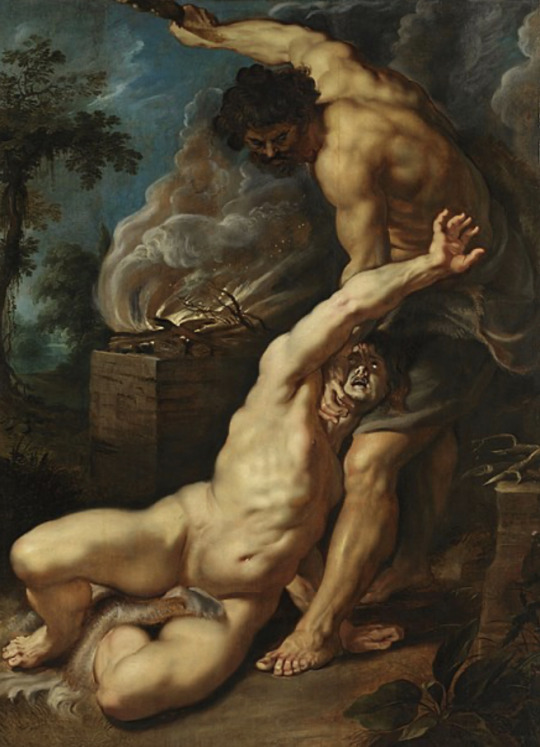
Cain Slaying his Brother Abel (Genesis 4:2-12) oil on oak wood (between 1608 and 1609) by Sir Peter Paul Rubens.
Sir Peter Paul Rubens (28 June 1577 – 30 May 1640) was a Flemish artist and diplomat from the Duchy of Brabant in the Southern Netherlands (modern-day Belgium). He is considered the most influential artist of the Flemish Baroque tradition. Rubens's highly charged compositions reference erudite aspects of classical and Christian history. His unique and immensely popular Baroque style emphasized movement, color, and sensuality, which followed the immediate, dramatic artistic style promoted in the Counter-Reformation. Rubens was a painter producing altarpieces, portraits, landscapes, and history paintings of mythological and allegorical subjects. He was also a prolific designer of cartoons for the Flemish tapestry workshops and of frontispieces for the publishers in Antwerp.[1]
The story of Baroque art in Flanders during the 17th century reflects the gradual decline of the country itself. Occupying the southern part of the Low Countries or Netherlands, it was ruled - along with the northern part of the Low Countries, known as Holland - by the unpopular Spanish Hapsburgs, who had taken over from the French Dukes of Burgundy. Its once powerful commercial and cultural centers, such as Bruges, Ghent and Antwerp, were weakened by religious and political disputes between the Catholic Hapsburg authorities and Protestant Dutch merchants. Thus while Dutch Baroque art flourished as never before, art in Flanders depended on a small handful of Flemish painters, mostly active in Antwerp.During the 15th century - the early days of the Italian Renaissance - Flemish painters had exported the technique of oil painting to artists in Florence, Rome and Venice. Now, at the beginning of the 17th century, with the spread of Italian Caravaggism, Flemish painters combined their own tradition with the tenebrist tradition arriving from Italy. This development was exemplified by the Antwerp artist Rubens (1577-1640). Since the High Renaissance, Flemish painting had been in transition between Northern and Italian influences; it was Peter Paul Rubens (1577-1640) who made the first real attempt to digest, absorb and fuse the two schools, creating a new style, well-suited to the more devout religious paintings called for by the Council of Trent's guidelines on Catholic Counter-Reformation Art (c.1560-1700), and which had a powerful impact on all painting north of the Alps.[2]
Below is an explanation of the Cain and Able story from real life and in the context of VTM. This is the same for all the Explained Cain slaying Able paintings in VTMB posts I’ve done so feel free to skip if you’ve already read this as it’s long.
___________________________________________________________
The tale of Cain murdering his brother Able are nearly identical in Jewish, Christian and Islamic texts with the oldest known version coming from the Dead Sea Scroll from the first century BCE. Cain was the the first born son of Adam and Eve and became a Farmer while Able was the second born son and became a shepherd. Both brothers made sacrifices to God, but God favored Abel's sacrifice instead of Cain's. In Islam the reason for their offerings is to decide which brother would marry Adam and Even’s first daughter who was also Cain’s twin sister. Able also had a twin sister and Adam wanted the brothers to marry the others twin. In multiple religions each brother has a twin sister but there is no consistently with the names as Cain’s twin sister being named Aclima, Kalmana, Lusia, Cainan, Luluwa, or Awan, and Able’s twin sister is named Jumella, Balbira or to make it more confusing Aclima (though even when she is called this Able’s twin sister is never the one the brothers are competing to marry) depending on the source. In the Islamic text Able’s offers his fattest sheep while Cain offered only a bunch of grass and some worthless seeds. In Jewish and Christian texts the reason for the sacrifices and the exact nature of their offerings are merely described as the first born of Ables heard and products from Cain’s fields.[3] The most description we get is in Genesis when God sees that Cain is upset that his offering was not chosen God tells Cain “: Why are you angry? Why are you dejected? If you act rightly, you will be accepted; but if not, sin lies in wait at the door: its urge is for you, yet you can rule over it.”(Genesis 4:6-7) Cain then told Able to meet him in his fields where he then murdered his brother out of jealousy by hitting Abel in the head with a stone. When God asks Cain where his brother Cain, “I do not know! he answered. Am I my brother’s keeper?”(Genesis 4:9) to which God replies “What have you done! The voice of your brother’s blood is calling to me from the ground. From now on you’ll get nothing but curses from this ground; you’ll be driven from this ground that has opened its arms to receive the blood of your murdered brother. You’ll farm this ground, but it will no longer give you its best. You’ll be a homeless wanderer on Earth.” (Genesis 4:10-12) When Cain objects saying the punishment is to great and that whoever finds him wandering shall kill him which then God says “No. Anyone who kills Cain will pay for it seven times over.” God put a mark on Cain to protect him so that no one who met him would kill him.” (Genesis 4:15). Cain then leaves east of Eden to wander in No-Mans-Land with his wife (who is not named in Genesis but is assumed to be his Twin sister in all tellings regardless of what name is given to her). Their first born Child was named Enoch, and Cain named the first city he built after his son. After Abel’s Death Adam and Eve had a Third son named Seth and when eve gave birth to him Eve said “God has given me another child in place of Abel whom Cain killed.”Genisis 4:25-26. In some texts Seths wife and sister is named Azura. Their son is named Enosh it is through Seth’s line that humanity stems from, though both Cain and Seth had multiple decedents and confusingly used the same names (see family tree below). None of Cain’s decedents suffered the curse of their father Cain but where still seen as sinful and apart from God and where killed in the great flood. How Cain died is not as an agreed upon topic. He was ether crushed to death by the stone house he built, an irony as he used a stone to slay his brother or in some versions part of the Mark of Cain had him grow horns and his descendent Lamech (not to be confused with Lamech who decedent from Seth and was the father of Noah) who was a blacksmith and had two wives(this is viewed as sinful) killed him mistaking him for a wild animal and killed his own son Tubal-cain in the process.

While in the lore of Vampire the Masquerade the tale of Cain killing his brother able as told in the Book of Nod stick to the original tale regarding the murder of Able but starts to differ in God’s punishment. "Father" cursed him with a mark, and cast him out to wander in darkness in the Land of Nod alone. There is no mention of a wife or if he was still cursed to be unable to farm however it is clear that Cain was not yet cursed to be a vampire by God. The Land of Nod was a place of utter darkness, with no source of light, where Caine was afraid and alone. There he found Lilith where they began a relationship and Cain realized that she possessed magical power and begged her to share them with him. While hesitant Lilith prepares an Awakening ceremony by cutting herself with a knife, bleeding into a bowl, and giving it to him so that he may drink. After Caine partakes of Lilith's blood, he is visited by three angels who are agents of God. Each angel offers Caine a chance to repent for the murder of Abel, but Caine rebuffed them out of pride. Michael, when denied, cursed Caine and his childer to fear his living flame. Raphael cursed Caine and his childer to fear the dawn, as the sun's rays would burn like fire. Uriel then cursed Caine and his childer to cling to Darkness, drink only blood, eat only ashes, and be frozen at the point of death, cursed so all they touch would crumble into nothing. A fourth angel, Gabriel, then appeared to offer the way of Golconda, the only way to "light", by the mercy of God. After the experience, Caine becomes officially "Awakened", possessing the following Disciplines: Celerity, Potence, Fortitude, Obfuscate, Dominate, Presence, Protean, Animalism, and Auspex. Caine then became aware of the Path of Blood, the Final Path from which all paths stem. And with all these powers, but now being cursed to be a vampire he breaks his bond with Lilith and leaves her.[3] While Cain never biologically fathers any children it is clear that their names of those he embraced and their decedents are inspired by the biblical names in his line though with massive changes. For instance the first city is founded by Cain in the land of Nod and and called Ubar and is explicitly stated to be settled by “Children of Seth” with the human king being Enoch at the time Cain settles there. Enoch still becomes his son as he is embraced by Cain. Another example of the reuse of a biblical name of cain’s line is Zillah (which in Hebrew means shade or protection). In the original story she is one of Lamech(decedent of Cain) two wives( the other named Adah). After both wives discover that Lamech unwittingly kills Tubal-Cain(one of Lamech and Zillah’s sons) they both refuse to have sex with him because of the deaths he caused, on the pretext that they do not desire to give birth to cursed offspring. The three go together to the tribunal of Adam; Adam rules that they must obey their husband since he killed unwittingly. This midrashic tradition portrays Adah and Zillah as respected women, whose position is considered in all seriousness by the court. [4] In VTM Zillah was a human woman who lived in Udar so beautiful, Caine could not resist the Embrace. According to Nosferatu Zillah is the one of Cain’s second generation who sired their Antediluvian. Interestingly, even after the Embrace, Zillah did not desire him. It frustrated Caine to the point that he was ripping his hair out of his head. He did anything and everything to make her desire him. Yet, she would not have him. Finally, Caine sought the Crone's magic, who ultimately tricked him into a blood bond, she forced the First Vampire to Embrace her. The Crone sent her new thrall away, telling him that his blood would have the power to bond others as Caine himself was bonded to the Crone. The discovery of the blood bond was what finally made Zillah agree to marry her sire Caine. [3]
[1] “Peter Paul Rubens.” Wikipedia, Wikimedia Foundation, 16 Mar. 2023, https://en.wikipedia.org/wiki/Peter_Paul_Rubens.
[2]“Flemish Baroque Art (1600-80).” Flemish Baroque Art (1600-80), ENCYCLOPEDIA OF ART HISTORY, http://www.visual-arts-cork.com/history-of-art/flemish-baroque.htm#flemishbaroque.
[3] “Caine.” White Wolf Wiki, https://whitewolf.fandom.com/wiki/Caine.
[4] Kadari, Tamar. “Zillah: Midrash and Aggadah .” Jewish Women's Archive, https://jwa.org/encyclopedia/article/zillah-midrash-and-aggadah#:~:text=Zillah%20was%20a%20wife%20of,he%20unwittingly%20kills%20Tubal%2DCain.
#VTMB#vampire the masquerade#cain and abel#sir peter paul rubens#flemish baroque art#Explaining one of VTMB paintings#VTM#Four painting for the price of one#book of nod
5 notes
·
View notes
Text
Caribbean Coinage!
So on a whim I decided to look into the money of the time the Heyder family. Pieces of Eight, Doubloons, Guineas are all common and popular sorts of money in pirate fiction, but what the hell do they actually mean? More importantly, what value did they hold among the everyday people living in the time? Well here’s what I think I’ve worked out, feel free to correct any mistakes I’ve made in my reading...
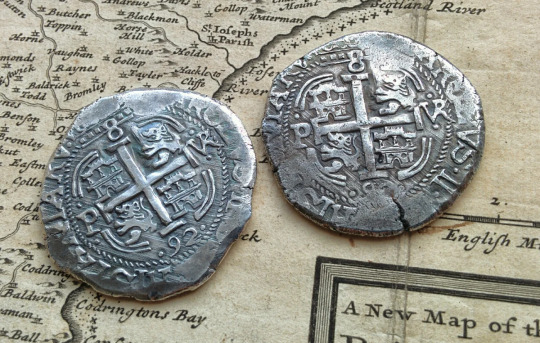
(Pictured: reproduction Pieces of Eight)
First we’ve got Spanish coinage, which generally consists of the Real, the Peso, the Escudo, the Pistole, and the Onza. The Real was the base coin, and it along with the Peso were made of silver. A single Peso was worth eight Reales, hence the nickname of “Piece of Eight”. An Escudo was a gold coin, and it was worth two Pesos. The “doubloon” was an English slang term for any Spanish gold coin, but it is commonly assumed to have meant to be in referral to the Pistole coin, as the name derives from “double” - hence, a Double Escudo. Spanish coin was largely considered the most valuable and profitable coinage in the Caribbean as it was for a long time the only coin minted in the New World.
8 Reales = 1 Peso (Piece of Eight)
2 Pesos = 1 Escudo
2 Escudo = 1 Pistole (Doubloon)
8 Escudo = 1 Onza

(Pictured: 17th century English Shilling)
Next is the English currency, which fun fact, is the world’s oldest longest running form of currency in history. Anyway, the English coinage consists of the Farthing, the Half-Penny (Hay Penny), the Penny (plurally known as Pence), the Shilling, the Crown, the Pound, and the Guinea. The Pound and the Guinea were nominally equal, just the Pound was silver and the Guinea was gold. Because of this, when the value of gold relative to silver went up, the Guinea could be worth up to 20% more than a Pound, but for simplicity’s sake I’ll keep them equal here (by the time Devil’s Eye begins anyway, the Guinea had been legally fixed at around that value anyway). The Guinea was also the second coin to be minted in the New World, starting around the 1660s, and thus became the primary competitor to the Spanish coinage system.
2 Farthings = 1 Half-Penny
4 Farthings = 1 Penny
12 Pence = 1 Shilling
5 Shillings = 1 Crown
20 Shillings, or 4 Crowns = 1 Pound
Now what gets interesting is the intersection between the English and Spanish values. Per weight and volume of precious metals, a Pound Sterling was equivalent to one Peso. Thus, a Doubloon was quadruple the value of a Guinea, which is probably why it is specifically “Spanish Gold” that seems to hold so much value in nautical fiction over any other coinage. For the curious, it takes 24 Pence to equal a Spanish Reale.

(Pictured: Dutch Lion Dollar from 1660)
The only Dutch coinage I found much reading on during this time period for colonial trade was Lion Dollar. Intentionally designed for international trade it’s value fluctuated between four and five Shillings, so it’s roughly equal to an English Crown. The English liked to mockingly call these “dog dollars” due to the fact it featured not a monarch (for the Netherlands had none) but a lion printed on it. I don’t have much to add here, if anyone knows more about international Dutch coinage and trade during the 17th and 18th centuries I’d like to hear about it. And of course, with simple math, we can surmise that it takes four to five Lion Dollars to equal a Pound, and thus 16 to 20 of them to equal a Doubloon.

(Pictured: a Louis d’Or from 1640)
Lastly there’s the French currency, which I honestly have found conflicting or at least unclear sources on. Gold Louis, or Louis d’Ors, are the gold standard from the 1640s onwards, originally meant to be equal in value to the Spanish Escudo (Doubloon). Historically what really made them important is that they were among the first machine-minted coins ever made, resulting in their symmetrical roundness, making chipping their edges for shavings difficult to do undetected.
Before the Louis d’Or came to be, French money was sort of a disorganized mess. Compared to the rest of Europe, France was still using coins dating back to the middle ages and late antiquity, namely the Livre which was supposed to equal a pound of silver, the Sou, which 20 were the equivalent to one Livre, and the Denier, which 12 were the equivalent to one Sou. These values were kept when the Louis d’Or was minted, and brought into line to equal the following:
48 Livres = 1 Double Louis d’Or
24 Livres = 1 Louis d’Or
12 Livres = 1 Demi- Louis d’Or
6 Livres = 1 Louis d’Argent (Silver Coin)
20 Sou = 1 Livre
12 Denier = 1 Sou
Curiously, there was never minted a 1 Livre coin. Also, the Denier was minted in values of 3 and 6. The Livre was cancelled as an actual coin, but kept as a unit of measurement of value. The Sou was about the same value as an English Penny, and as stated earlier the intent of the Louis d’Or was to equal the Spanish Pistole in value.
It takes 192 Pence to equal a Pound, which is roughly the same as a Peso/Piece of Eight. It takes four Pesos to equal a Pistole, which is the commonly accepted value for a Doubloon. So it takes 768 Pence to equal a Doubloon.
But if 20 Sou equals a Livre, and a Louis d’Or is worth 24 Livre, that means a Louis d’Or is worth only 480 Sou... but the Sou was thought to be equal to the Penny. How come the Louis d’Or is worth almost double that much? Could it be it was the Denier that is worth as much as a Penny? In that case, a Louis d’Or would be worth as much as 5760 Pence! So I really have no idea what’s going on with the value of the Louis d’Or. It could be information is just incomplete or even as simple as contradictory, but regardless it is amusing that France felt obligated to make their national gold currency the most valuable of the lot.
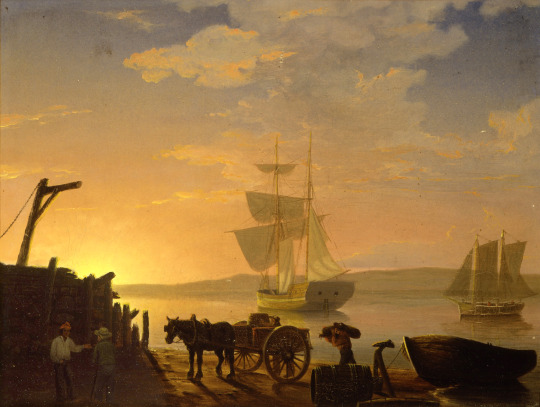
So what all the fuss for this anyway? Well in Devil’s Eye, when the Heyder family comes to join the crew of Captain Hurley’s Barracuda, the ship is sorely lacking in remaining crew. She has her captain, the navigator, the cook and carpenter, and a doctor. Part of what led to their financial woes once they surrendered piracy? A diminished crew means no purser and no quartermaster. Ravyn may be strong willed and witty, but economical she is not - nor is the helmsman Amir, the cook and carpenter Singlung, or their doctor calling himself Tripoli.
Fortunately for them, the Heyders joining brings along a very well traveled and financially savvy man in Robert... so it falls to him to manage the Barracuda’s finances and supply logistics. His daughter Helen and son Jacob are adept assistants in the matter as well.
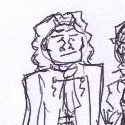
“With Captain Ravyn’s habits, it’s a pretty thankless job at that. For someone who wants all of the money ever, she’s pretty irresponsible at throwing it around without making sure the exchanges are right.”

“You know when you tell someone you don’t have the time or money to make something happen, and they tell you to make it happen anyway? That’s Captain Hurley.”

“It’s a uniquely Ravyn sort of headache. I don’t have to put up with that nonsense with La Demonia’s crew at least.”
#REAL HISTORY#semi-IC#Robert Heyder#Jacob Heyder#Helen Heyder#i spent all night doing this skub nonsense instead of being productive GO ME
5 notes
·
View notes
Text
Happy Independence Day! I am very proud to have ancestors who fought in the revolutionary war (against the Brits of course 😉). On my dad's side, they came from Britain and the Netherlands in the 1640s and first settled in what would become New Jersey.

6 notes
·
View notes
Photo

View of Batavia with the mountain range of the Salak, Pangerango and Gede. 1640-76
by Hendrick Dubbels
Oil on canvas, 1640
Rijksmuseum, Amsterdam, The Netherlands
#Hendrick Dubbels#fineart#art#painting#artwork#masterpiece#fineartprint#gallery#museum#salak#dubbels
3 notes
·
View notes